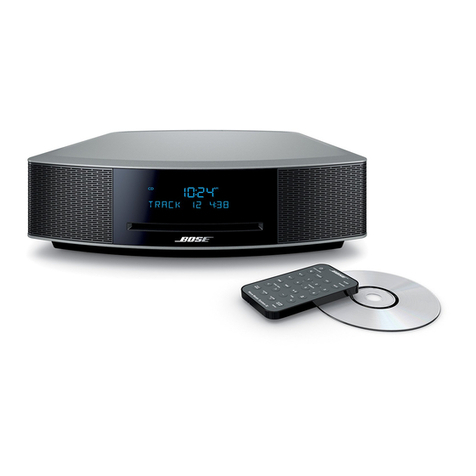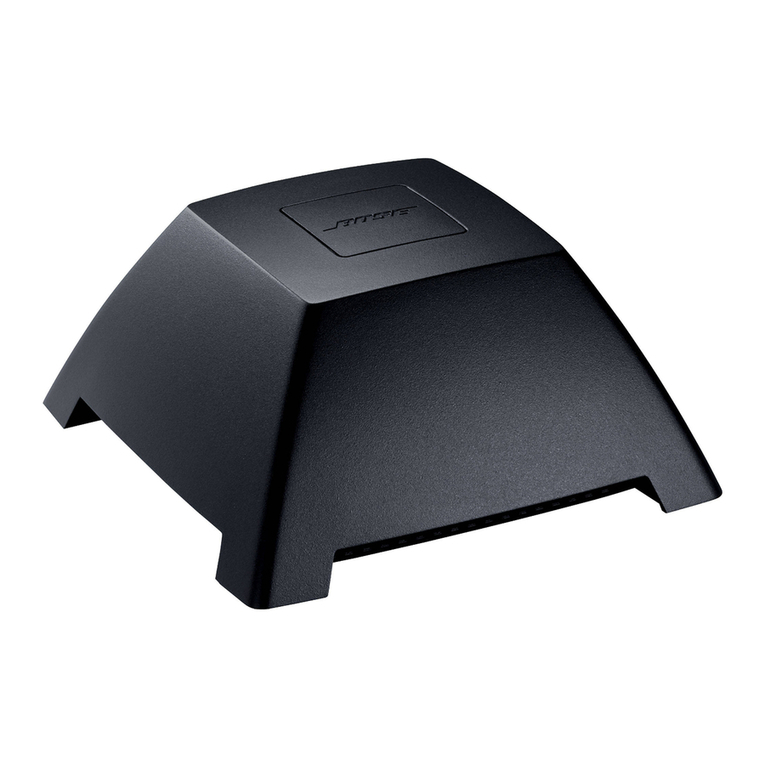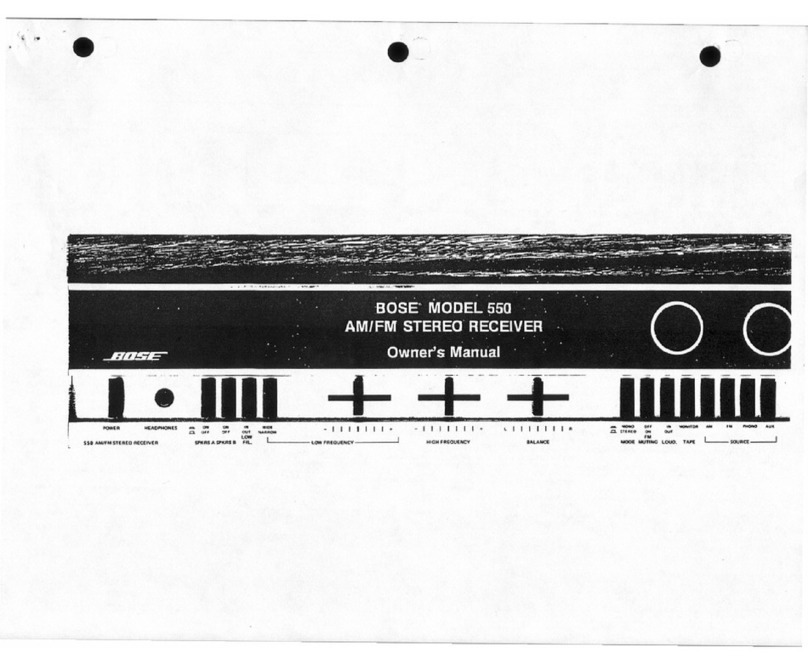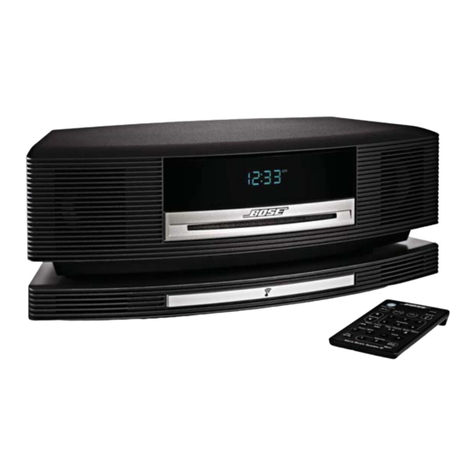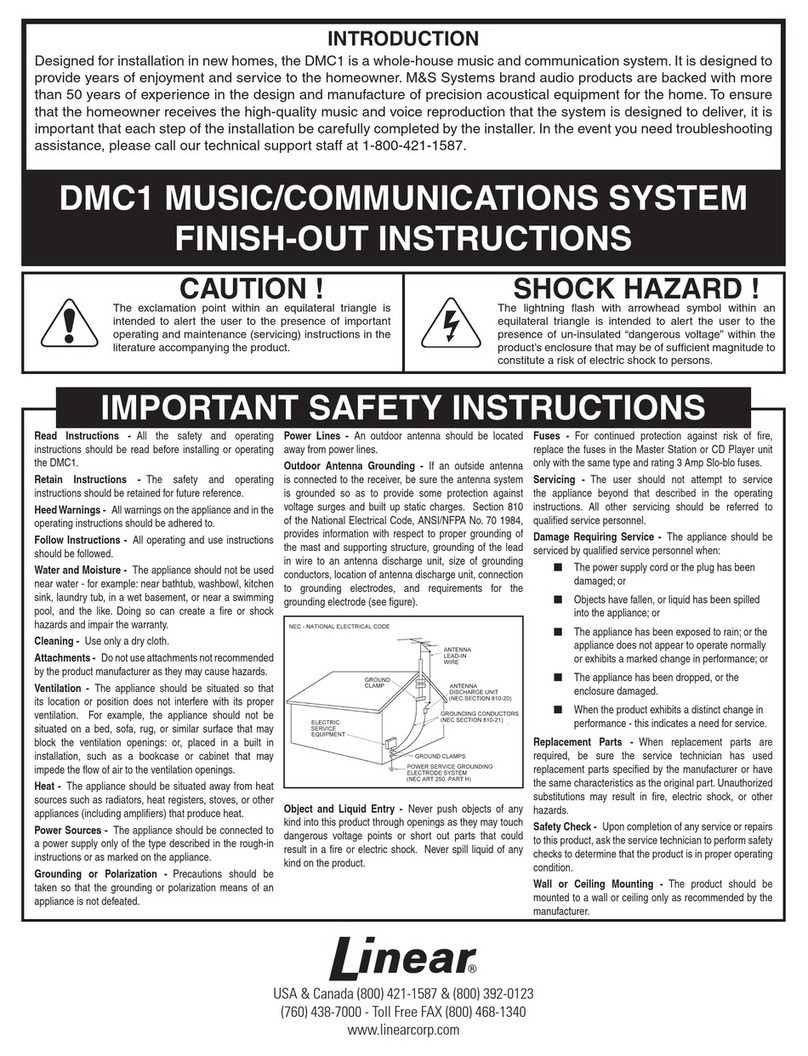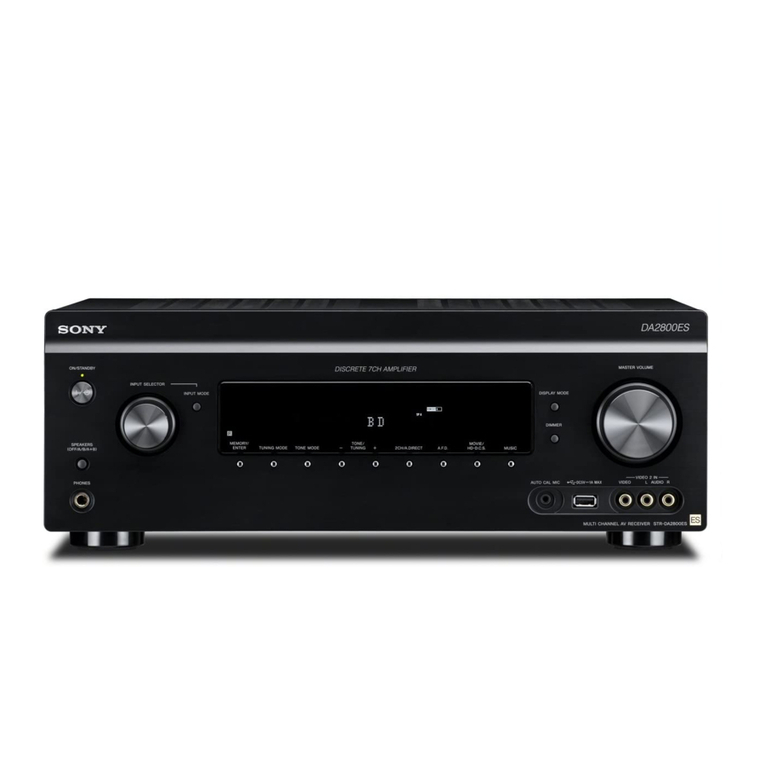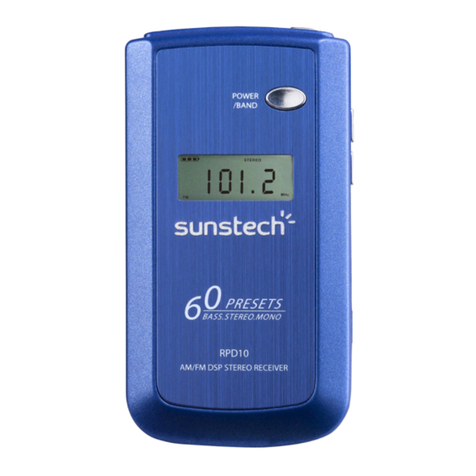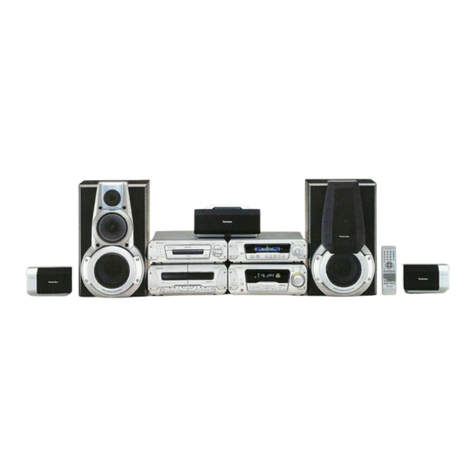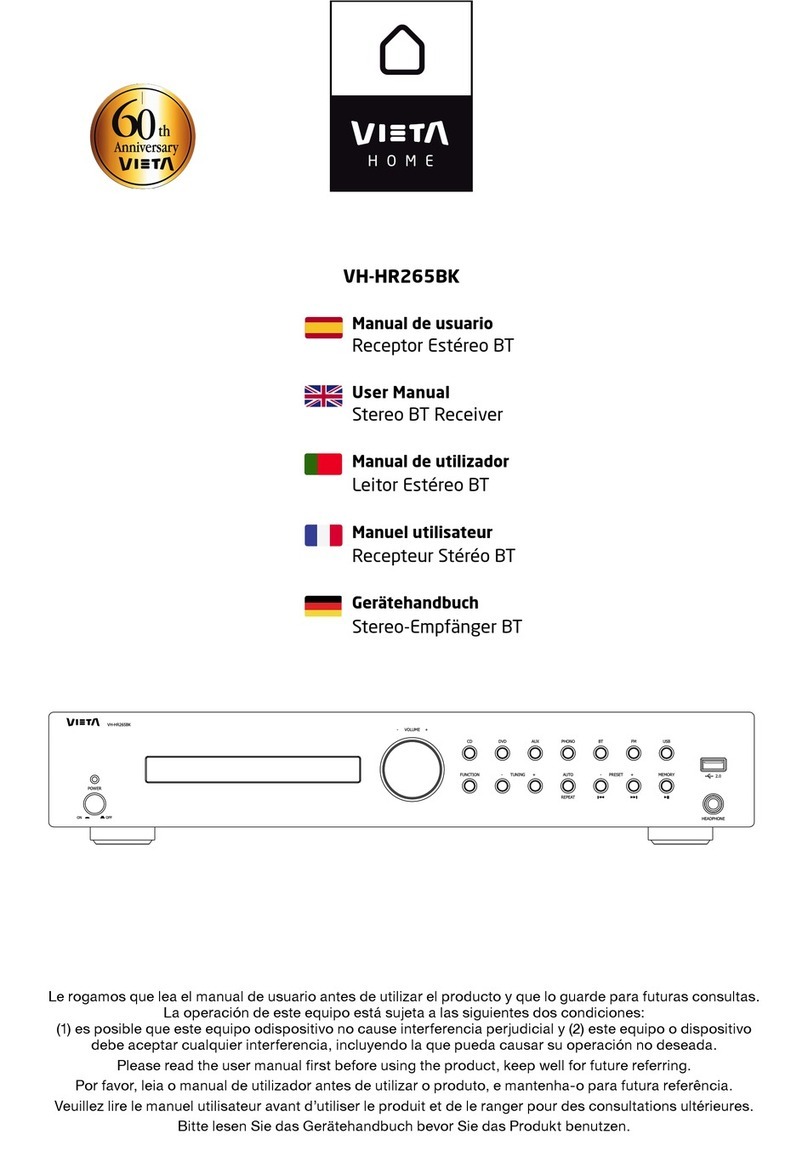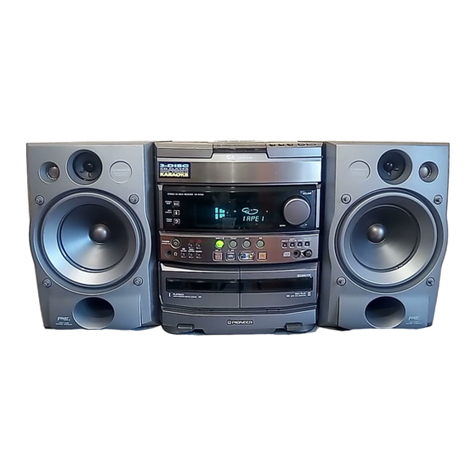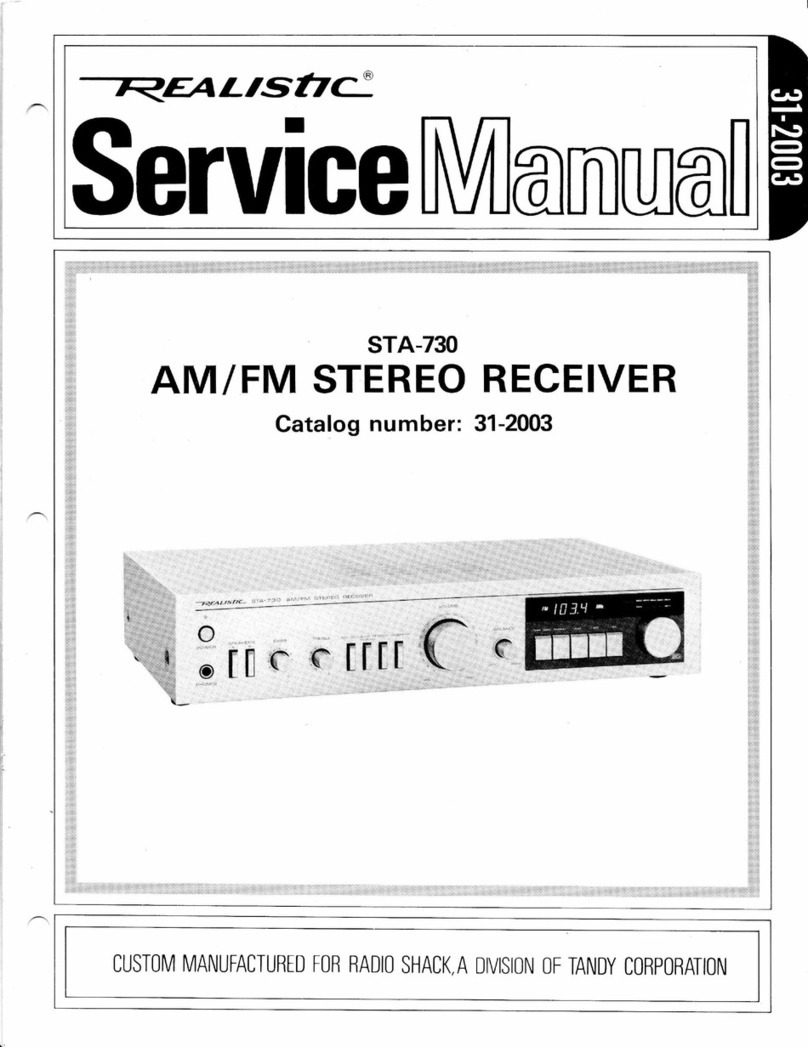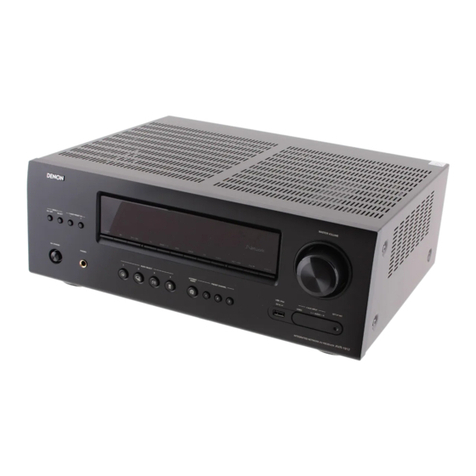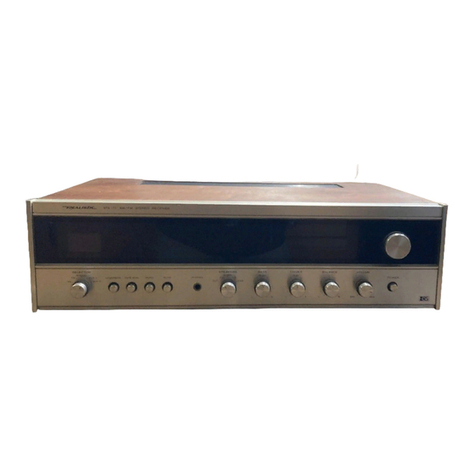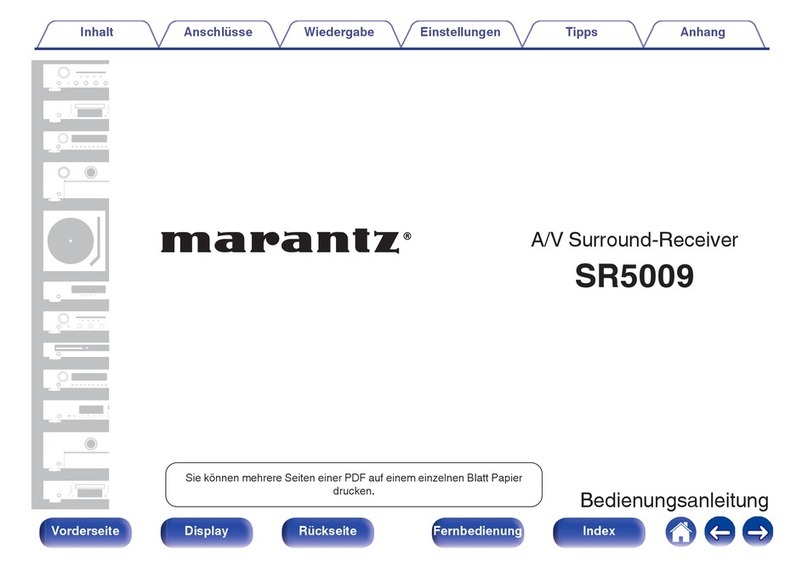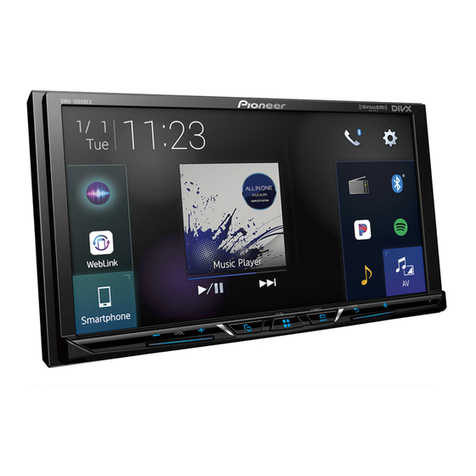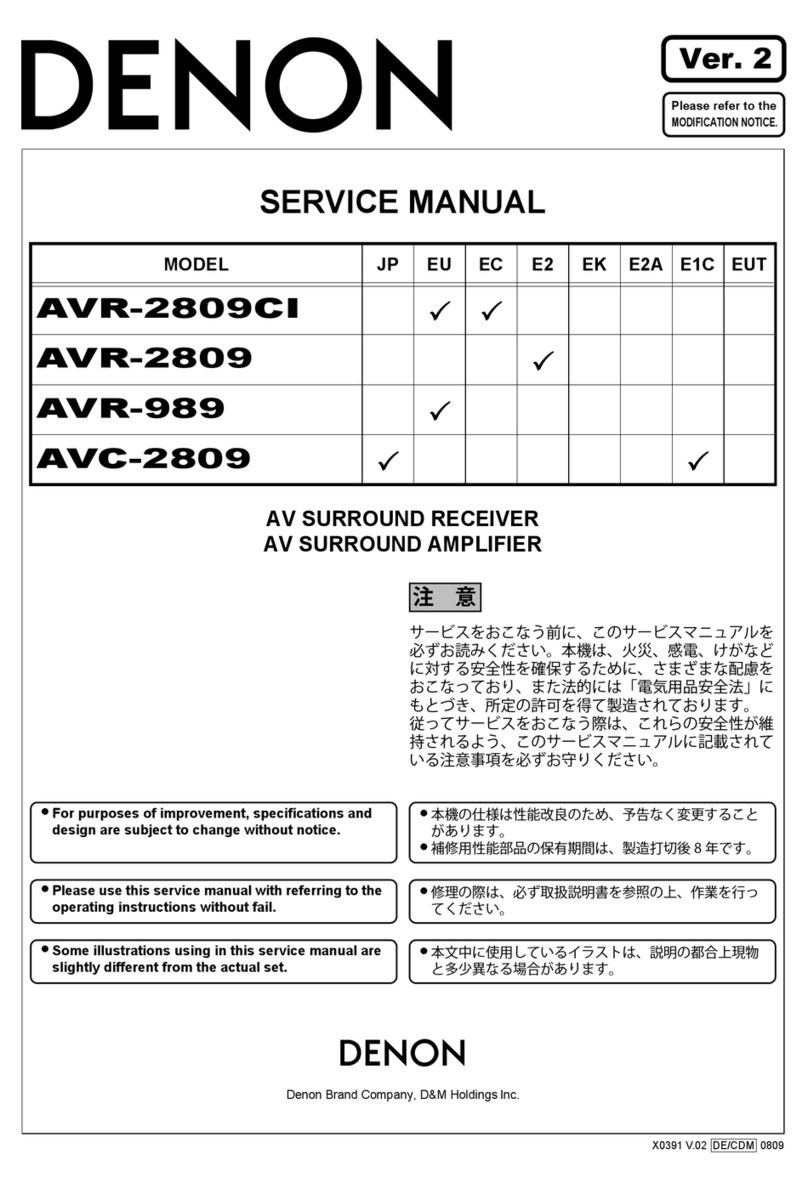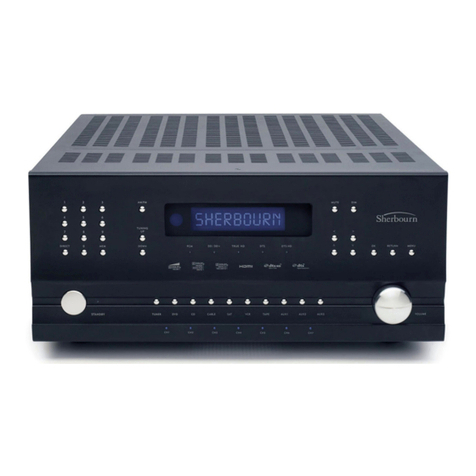Bose LIFESTYLE 550 User manual

Model 550
AM/FM Stereo Receiver
®
®
Part Number 112429 REV 01
Service Manual

2
Contents
Safety Information............................................................................................................................ 3
Electrostatic Discharge Sensitive (ESDS) Device Handling ........................................................ 4
Specifications................................................................................................................................ 5-6
Technical Description ...................................................................................................................... 7
Disassembly/Assembly Procedures ......................................................................................... 8-10
Figure 1. Antenna Placement Diagram .......................................................................................... 10
Test Procedures ........................................................................................................................ 11-14
Figure 2. AM/FMAdjustment Location ........................................................................................... 12
Figure 3. Amp Adjustment Location ...............................................................................................14
Figure 4. Block Diagram.................................................................................................................15
Figure 5. Wiring Diagram ............................................................................................................... 16
Figure 6. Main PCB Layout ............................................................................................................ 17
Figure 7. PCB Layout..................................................................................................................... 18
Figure 8. Exploded View ................................................................................................................ 19
Figure 9. Dial String Diagram......................................................................................................... 20
Figure 10. Pinout Location Diagram...............................................................................................21
Part List Notes................................................................................................................................ 22
Part List...................................................................................................................................... 23-30
Voltage Conversion Instructions .................................................................................................. 31

3
SAFETY INFORMATION
1. Parts that have special safety characteristics are identified by the symbol on
schematics or by special notes on the parts list. Use only replacement parts that
have critical characteristics recommended by the manufacturer.
2. Make leakage current or resistance measurements to determine that exposed
parts are acceptably insulated from the supply circuit before returning the unit
to the customer. Use the following checks to perform these measurements:
A. Leakage Current Hot Check-With the unit completely reassembled, plug
the AC line cord directly into a 120VAC outlet. (Do not use an isolation
transformer during this test.) Use a leakage current tester or a metering
system that complies with American National Standards Institute (ANSI)
C101.1 “Leakage Current for Appliances” and Underwriters Laboratories
(UL) 1492 (71). With the unit AC switch first in the ON position, then in the
OFF position, measure from a known earth ground (metal water pipe,
conduit, etc.) to all exposed metal parts of the unit (antennas, handle bracket,
metal cabinet, screwheads, metallic overlays, control shafts, etc.), especially
any exposed metal parts that offer an electrical return path to the chassis.
Any current measured must not exceed 0.5 milliamp. Reverse the unit power
cord plug in the outlet and repeat test. ANY MEASUREMENTS NOT WITHIN
THE LIMITS SPECIFIED HEREIN INDICATE A POTENTIAL SHOCK HAZ-
ARD THAT MUST BE ELIMINATED BEFORE RETURNING THE UNIT TO
THE CUSTOMER.
B. Insulation Resistance Test Cold Check-(1) Unplug the power supply and
connect a jumper wire between the two prongs of the plug. (2) Turn on the
power switch of the unit. (3) Measure the resistance with an ohmmeter be-
tween the jumpered AC plug and each exposed metallic cabinet part on the
unit. When the exposed metallic part has a return path to the chassis, the
reading should be between 1 and 5.2 Megohms. When there is no return path
to the chassis, the reading must be “infinite”. If it is not within the limits specified,
there is the possibility of a shock hazard, and the unit must be repaired and re-
checked before it is returned to the customer.

4
ELECTROSTATIC DISCHARGE SENSITIVE (ESDS)
DEVICE HANDLING
This unit contains ESDS devices. We recommend the following precautions when repairing,
replacing or transporting ESDS devices:
• Perform work at an electrically grounded work station.
• Wear wrist straps that connect to the station or heel straps that connect to conductive floor
mats.
• Avoid touching the leads or contacts of ESDS devices or PC boards even if properly
grounded. Handle boards by the edges only.
• Transport or store ESDS devices in ESD protective bags, bins, or totes. Do not insert unpro-
tected devices into materials such as plastic, polystyrene foam, clear plastic bags, bubble wrap
or plastic trays.
CAUTION: THE 550 RECEIVER CONTAINS NO USER-SERVICEABLE PARTS. TO PRE-
VENT WARRANTY INFRACTIONS, REFER SERVICING TO WARRANTY SERVICE STA-
TIONS OR FACTORY SERVICE.

5
SPECIFICATIONS
Phono Overload: 100 mV
Loudness Contour: +8 dB @ 100 Hz (±2 dB) +6 dB @ 12kHz (±2 dB)
AM Tuner: 20 dB Usable Sensitivity
Adjacent Channel Selectivity
Total Distortion
Image Rejection
IF Rejection
Signal to Noise Ratio
350 uV (ferrite loopstick)
35 dB
.9% (400 Hz @ 30%
Modulation)
37 dB
45 dB
40 dB
FM Tuner: IHF Usable Sensitivity
50 dB Quieting Sensitivity
Frequency Response
Signal to Noise Ratio @ 65 dBf
THD @ 65 dBf
Capture Ratio
Alternate Channel Sensitivity
Spurious Response Rejection
Image Rejection
AM Rejection
Stereo Separation, 1kHz
2.0 uV/11.25 dBf (Mono)
3.5 uV/16.11 dBf (Stereo)
3.8 uV/16.82 dBf (Mono)
35 uV/37.27 dBf (Stereo)
30 Hz - 15kHz, +1.0 dB - 3.0 dB
65 dB (Mono)
60 dB (stereo)
.25% (Mono)
.50% (Stereo)
1.9 dB
60 dB
80 dB
65 dB
50 dB
40 dB
Channel Separation: AUX. and Tape
Phono
60 dB @ 1kHz (at Tape - Out)
55 dB @ 1kHz (at Tape - Out)

6
SPECIFICATIONS
Input Sensitivity
Impedance:
Capacitance:
Aux. and Tape
Phono
150 mV/ 50k Ohm
2.75 mV/ 47k Ohm, 150 pF
Source and Room
Compensation
Controls:
Low Filter
Low Frequency Control
Narrow Position
Wide Position
High Frequency Control
-3 dB @ 100Hz
-7 dB max. @ 20Hz
±8 dB @ 140Hz
(center frequency)
±1 dB @ 20Hz and 1kHz
±3 dB @ 350Hz
±8 dB @ 50Hz
±8 dB @ 15kHz
±3 dB @ 2.2kHz
Frequency Response: 20 Hz to 20 kHz
Phono RIAA
±0.5 dB
±0.5 dB
Amplifier Power
Output: 40 Watts per Channel minimum
RMS continuous power @ 8
Ohms, THD < .3%
20Hz to 20kHz
IHF Power Bandwidth: 20Hz to 20kHz both channels driven THD <.19%
Intermodulation
Distortion: .09% IHF 60 Hz/7kHz 4:1 mixed at rated
output
Signal to Noise Ratio: Amplifier
Phono
87 dB A- weighted (below rated
output) inputs shorted
91 dB A- weighted (below rated
output) min. volume
76 dB A- weighted (below rated
output) inputs shorted
Power Requirements: 120 Volts AC 60 Hz
(USA model) 220 Volts AC 50-60 Hz
(export model)
Power Consumption: 360 Watts at rated power
AC Outlets: 1 switched, 1 unswitched 400 watts max.
Dimensions: 18 1/4" x 5 3/4" x 12 1/4" 46.6 (w) x 14.6 (h) x 31.1 (d) cm
Weight: 15 1/2 lbs 7 Kg

7
The Model 550 AM/FM Stereo Receiver features a high quality AM/FM Stereo tuner and a
direct-coupled amplifier with 40 watts of RMS power per channel.
The Model 550 includes a built-in 901®Series IV equalizer, that provides extra value and
convenience to present owners and future purchasers of Bose®901 loudspeakers. The built-in
equalizer can be switched into the circuit when playing Bose 901 Series III or Series IV speak-
ers. You can pre-set the Model 550 via the rear panel switches for various combinations of
loudspeakers. This provides correct equqlization when switching from one pair of speakers to
the other.
The receiver incorporates Source and Room Compensation Controls unique to Bose electronic
equipment. These controls allow you to compensate more accurately for problems in room
acoustics and recordings. The result is greater realism and enjoyment.
TECHNICAL DESCRIPTION

8
DISASSEMBLY/ASSEMBLY PROCEDURES
Note: Numbers in parentheses corre-
spond to the callouts in Figure 8.
1. Top Cover Removal
1.1 Remove the 4 screws (A-14) located
on each side of the unit.
1.2 Lift the top cover (A-2) off of the unit.
2. Top Cover Replacement
2.1 Place the top cover onto the top of the
unit.
2.2 Secure the top cover to the unit.
3. Bottom Cover Removal
3.1 Remove the 5 screws (L-13) that
secure the bottom cover (A-3) to the unit.
3.2 Remove bottom cover.
4. Bottom Cover Replacement
4.1 Place the bottom cover onto the unit.
4.2 Secure the bottom cover to the unit.
5. Front Panel Removal
5.1 Perform procedures 1 and 3.
5.2 Remove the volume, tuning, and slide
pot knobs.
5.3 Locate and remove the 3 screws (L-3)
that secure the front panel (A-1) to the top
front of the unit.
5.4 Unclip the 4 plastic clips located at the
bottom of the front panel and remove the
panel from the unit.
6. Front Panel Replacement
6.1 Place the front panel onto the unit and
clip the bottom of the front panel into place.
6.2 Secure the top of the front panel and
replace the knobs.
7. 901®EQ PC Board Removal
Note: There is no callout on Figure 8. for
the EQ board. The 901 EQ board is located
under the dial lamp and behind the slide
pots.
7.1 Perform procedures 1 and 3.
7.2 Using a pair of pliers, unclip the three
plastic standoffs holding the board in place.
8. 901 EQ PC Board Replacement
8.1 Align the standoffs over the holes in
the main PC board. Push the 901 EQ
board into place.
9. Slide Pot Removal
9.1 Perform procedures 5 and 7.
9.2 Unscrew the two screws (L-12) that
secure each of the slide pots to the front of
the unit.
9.3 Remove the slide pots through the
bottom of the unit.
10. Slide Pot Replacement
10.1 Guide the slide pot assembly through
the bottom of the unit and place it into the
front of the unit.
10.2 Secure the slide pots to the unit.

9
DISASSEMBLY/ASSEMBLY PROCEDURES
11. Dial Lamp Assembly Removal
11.1 Perform procedure 1.
11.2 Carefully slide the dial lamp PC board
to the left (with the unit facing you) and lift
the board off of the clips.
11.3 Lift the board up towards the top of
the unit and replace any defective bulbs.
12. Dial Lamp Assembly Replacement
12.1 Position the dial lamp PC board over
the locking clips.
12.2 While aligning the clips with the holes
in the PC board, carefully slide the board to
the right to secure it to the lamp housing.
13. Selector Lamp Assembly Removal
13.1 Perform procedure 7.
13.2 Remove the screw (L-1) securing the
PC board to the front housing.
13.3 Unclip the ends of the board and
remove it from the housing.
13.4 Replace any bulbs that are defective.
14. Selector Lamp Assembly Replace-
ment
14.1 Place the PC board into the housing
and clip it into place.
14.2 Secure the board to the housing.
15. Meter Lamp Assembly Removal
15.1 Perform procedure 1.
15.2 Remove the screw (L-1) securing the
meter lamp PC board to the housing.
15.3 Cut any tie wraps needed and re-
move the PC board from the housing.
15.4 Replace any defective bulbs.
16. Meter Lamp Assembly Replacement
16.1 Place the PC board into the housing
and secure it to the housing.
16.2 Replace any tie wraps that had been
removed.
17. Volume Control Removal
17.1 Perform procedure 5.
17.2 Remove the nut securing the volume
control to the front housing and remove the
control from the rear of the housing.
18. Volume Control Replacement
18.1 Place the volume control through the
rear of the front housing.
18.2 Secure the volume control to the
front housing.
19. Power Switch Removal
19.1 Perform procedure 5.
19.2 Remove the two screws securing the
power switch to the front assembly.
19.3 Remove the power switch through
the bottom of the unit.
20. Power Switch Replacement
20.1 Place the power switch into the front
assembly.
20.2 Secure the power switch to the front
assembly.

10
TEST PROCEDURES
1. AM Tuner Adjustment Procedure
Note: Refer to the antenna placement
diagram Figure 1.
1.1 Connect anAM signal generator to an
AM loop antenna. Set the frequency ac-
cording to the AM alignment procedure
listed below.
1.2 Connect a voltmeter to the tape output
jacks on the rear panel.
1.3 Refer to the adjustment location chart
(Figure 2.) for the location of the tuning
coils called out in the AM alignment proce-
dure.
2. FM/MPX Tuner Adjustment
2.1 Connect an FM signal generator to the
antenna terminals on the rear panel.
2.2 Connect a voltmeter to the tape output
jacks on the rear panel.
2.3 Refer to the adjustment location chart
(Figure 2.) for the location of the tuning
coils called out in the FM/MPX alignment
procedure.
2.4 Perform the tests listed on the next
page for the FM and MPX sections.
AM Alignment Procedure
,,,,,
,
,,,
,
,
,,,
,
,
,,,
,
,
,,,
,
,
,,,
,
,
,,,
,
,,,,,
,,
,,
,,
,,
STANDARD
SIGNAL
GENERATOR
STANDARD
SIGNAL
GENERATOR
60cm
TEST
LOOP BAR
ANTENNA
(PLAN VIEW)
(SIDE VIEW)
,,
,,
,,
,,
,,
,,
,,
,,
,,,
,
,
,
,
,
,
,
,
,
,,,
Figure 1. Antenna Placement Diagram

11
TEST PROCEDURES
MPX Alignment Procedure
FM Alignment Procedure

12
Figure 2. AM/FM Adjustment Location

13
TEST PROCEDURES
3. Loudness Control Procedure
Note: Use the following control settings.
Slide pots centered, speaker A switch
selected with the output connected to an 8
ohm load, all switches out except for the
aux switch.
3.1 Apply a 100Hz signal at 1Volt to the
aux input.
3.2 Rotate the volume control until 1.5
Vrms is measured at the output.
3.3 Reference a dB meter to the output.
3.4 Push the loudness switch IN. There
should be a +8dB change in response at
the output.
3.5 Change the signal to 12kHz and repeat
step 3.3 and 3.4. There should be a + 6dB
change in response at the output.
4. Low Filter Procedure
4.1 Perform procedure 3.1, 3.2, and 3.3.
4.2 Push the low filter switch IN. There
should be a -3dB change in response at the
output.
4.3 Change the input frequency to 20Hz
and reference a dB meter to the output.
4.4 Push the low filter switch IN. There
should be a -7dB change in response at the
output.
5. Low Frequency Control Procedure
5.1 Apply a 140Hz signal at 1Volt to the
aux input.
5.2 Rotate the volume control until 1.5
Vrms is measured at the output.
5.4 Slide the control from one side to the
other. There should be a + 8dB and -8dB
change in response ( ±1dB) from the
center.
5.5 Push the wide/narrow switch IN.
Change the frequency to 350Hz. With the
low frequency control centered reference a
dB meter to the output.
5.6 Slide the control from side to side.
There should be a +3dB and -3dB change
in response (±1dB) from the center.
6. High Frequency Procedure
6.1 Apply a 15kHz signal at 1Volt to the
aux input.
6.2 Reference a dB meter to the output.
6.3 Slide the high frequency control from
side to side. There should be a +8dB and
-8dB change in response (±1dB) at the
output.
6.4 Change the input signal to 2.2kHz.
Slide the control from side to side. There
should be a +3dB and -3dB change in
response (±1dB) at the output.
7. 901®EQ Response Procedure
7.1 Apply a 250Hz signal 1Volt to the aux
input. Reference a dB meter to the output.
7.2 Switch the EQ switch located on the
rear panel from the other position to the
901 position. There should be a -1dB
change in response at the output.
5.3 Reference a dB meter to the output
with the low frequency control centered and
the wide/narrow switch in the OUT position.

14
TEST PROCEDURES
Figure 3. Amp Adjustment Location
8. Amplifier Adjustment Procedure
Note: Preheat the unit for about 20 minutes
prior to performing the following procedure.
8.1 Connect a DC voltmeter to the test
points TP 501-502 (across R536) for the
right channel and at TP 503-504 (across
R537) for the left channel see Figure3. for
the TP locations.
8.2 Connect the output to an 8 ohm load,
volume set to the minimum position, with no
signal applied.
8.3 Adjust VR452 for the right channel and
VR451 for the left channel to a setting of
7mV at the test points.
901® Response Chart
Frequency Output Tolerence
40Hz +16dB ±2dB
250Hz 0dB
Reference ----
700Hz -7.0dB ±2dB
10kHz +16dB ±2dB
14kHz +21dB ±2dB
7.3 Reference a dB meter to the output.
7.4 Check the response using the chart
below.

15
Figure 4. Block Diagram
Left Channel ( Same as Right Channel)

Figure 5. Wiring Diagram
16

17
Figure 6. Main PCB Layout

18
Figure 7. PCB Layout

Figure 8. Exploded View
19

20
Figure 9. Dial String Diagram
Other manuals for LIFESTYLE 550
3
Table of contents
Other Bose Stereo Receiver manuals
